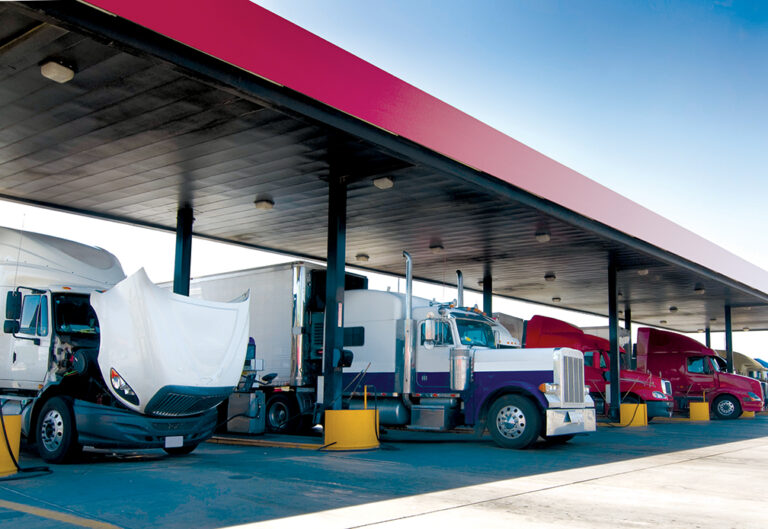Things are tough all over. There is still freight to haul, but there’s more competition for it. In the meantime, expenses are up and rates are down — and it’s likely to get worse before it gets better.
The American Trucking Associations (ATA) reported a decline of 2% in freight hauled by member carriers in May. The ATA release said freight levels had climbed for eight consecutive months prior to the April decline.
“It is important to note that ATA’s for-hire tonnage data is dominated by contract freight with minimal amounts of spot market loads,” said Bob Costello, chief economist for ATA. “The spot market has softened more than for-hire contract freight, as the market transitions back to pre-pandemic shares of contract versus spot market.”
Costello is referring to economic conditions that saw a surge in retail products during the COVID-19 pandemic, many of which are shipped on the spot market. Much contract freight hauled goes to the manufacturing industry, which suffered shutdowns and slowdowns during the pandemic.
Today, consumer spending on retail items is slowing, with higher gasoline prices and inflation taking up more of the family dollars.
The Cass Freight Indexes, published by Cass Information Systems, showed an April decline in shipments of 2.6% over March and 3.5% compared to April 2021. The Cass Index measures multiple modes of transportation including rail, air, ship and pipeline, in addition to trucking.
The Cass Index for May reversed the trend, showing a 5.4% increase in total shipments. The expenditures index, however, went in the other direction: Total shipping expenditures fell by 4.9% from April. The Cass release stated, “After a nearly two-year cycle of surging freight volumes, two key drivers of growth for the freight cycle — goods consumption and inventory restocking — are faltering.”
Another factor reported in the Cass report is the ACT For-Hire Trucking Survey: Supply-Demand Balance. For this metric, available freight represents demand and capacity, and the number of available trucks represents supply. The ACT index has been showing more demand than the trucking industry could provide trucks to haul for 21 consecutive months. That changed in March, with a change to the supply side.
There is less freight and more trucks to haul it.
One reason there are more trucks is that there are more drivers; the driver shortage many large carriers have complained about is seeing some relief. Avery Vise, vice president of trucking for FTR, explained one of the reasons.
“Net revocations of for-hire authority approached 9,300 (in May) and were more than double the number recorded in April, and were a record,” he said in a June 6 podcast.
Vise explained that it takes time to revoke authority, which often occurs when the owner’s insurance lapses. Because there’s a 30-day grace period for premium payment, revocations that occurred in May were carrier businesses that failed in March or April.
As spot rates rose over the past two years, record numbers of drivers bought trucks and sought their own authority to take advantage of the high rates. Now it seems the opposite is beginning to happen: Lower rates and high expenses are causing some to sell (or surrender) their trucks and take jobs as company drivers.
According to the Bureau of Labor Statistics, trucking added more than 27,000 jobs in April and May. Not all of them were driving jobs, of course, but a large percentage of them were, allowing carriers to put trucks that were previously parked back on the road.
When the number of trucks increases and the amount of freight decreases, spot rates suffer first.
Where spot rates are generally posted for loads that are currently available, contract rates can be negotiated months in advance and may not always represent current market conditions. Contract rates usually follow spot rates, but the results take longer to show up because carriers must negotiate new rates with their customers before changing them.
“While I expect contract freight to outperform spot market freight, the rate of growth will be slower than in 2021,” added ATA’s Costello. “Most contract carriers are still struggling with maintaining enough capacity, both equipment and drivers.”
As spot rates continue to decline, as they have for the past four months, carriers that depend on the spot market will continue to struggle with higher fuel prices and increased inflation.
According to the latest DAT Trendlines, spot rates for van loads have fallen more than 10% since March, when the average rate per mile was $3.02. That rate fell to $2.79 in April and then to $2.71 in May. The report notes that van rates typically rise by eight cents per mile in June, but it hasn’t happened this year.
Refrigerated freight followed a similar trajectory, dropping from $3.41 in March to $3.15 in April and then to $3.07 in May for a total decline of just under 10%.
The bright spot in the trend goes to the flatbed sector, which may be benefiting from seasonal changes as construction activity picks up. Flatbed rates have climbed from $3.40 in March and were up two cents per mile in April; rates reached $3.45 in May and had climbed to $3.48 by mid-June.
The bad news, however, is the cost of fuel. The national average price for a gallon of diesel fuel reached $5.72 in mid-June, 47 cents higher that it was at the end of March, according to the U.S. Energy Information Administration. Prices easily topped $6 per gallon on the West Coast, reaching an average of $6.89 in California.
When a fuel surcharge (or equivalent amount) is subtracted from spot rates, it is evident that rates have fallen much farther. Truckstop.com, in conjunction with FTR, reported that dry van rates from its load board, posted in the second week of June, were 10% lower than June 2021, but about 29% lower is an “imputed” fuel surcharge is factored in. Refrigerated loads were 28% lower. Even flatbed rates, which have risen, are 4% lower when fuel surcharge is factored.
It was only a matter of time until the trucking upcycle ended. Belt-tightening and judicious management will be needed for the downcycle to come.
Cliff Abbott is an experienced commercial vehicle driver and owner-operator who still holds a CDL in his home state of Alabama. In nearly 40 years in trucking, he’s been an instructor and trainer and has managed safety and recruiting operations for several carriers. Having never lost his love of the road, Cliff has written a book and hundreds of songs and has been writing for The Trucker for more than a decade.















